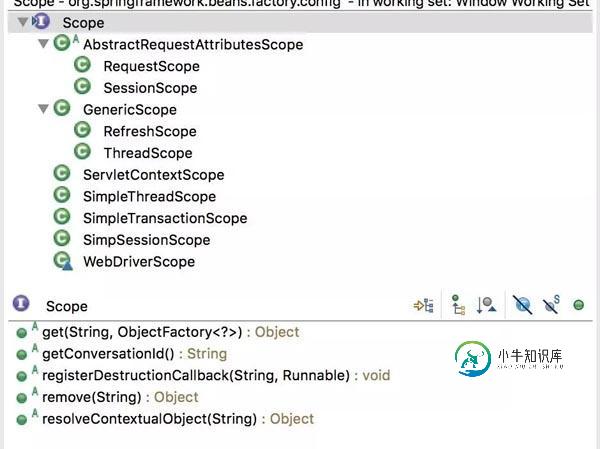Spring Cloud @RefreshScope 原理及使用
@RefreshScope那些事
要说清楚RefreshScope,先要了解Scope
- Scope(org.springframework.beans.factory.config.Scope)是Spring 2.0开始就有的核心的概念
- RefreshScope(org.springframework.cloud.context.scope.refresh)是spring cloud提供的一种特殊的scope实现,用来实现配置、实例热加载。
- Scope -> GenericScope -> RefreshScope

Scope与ApplicationContext生命周期
AbstractBeanFactory#doGetBean创建Bean实例
protected <T> T doGetBean(...){
final RootBeanDefinition mbd = ...
if (mbd.isSingleton()) {
...
} else if (mbd.isPrototype())
...
} else {
String scopeName = mbd.getScope();
final Scope scope = this.scopes.get(scopeName);
Object scopedInstance = scope.get(beanName, new ObjectFactory<Object>() {...});
...
}
...
}
Singleton和Prototype是硬编码的,并不是Scope子类。 Scope实际上是自定义扩展的接口
Scope Bean实例交由Scope自己创建,例如SessionScope是从Session中获取实例的,ThreadScope是从ThreadLocal中获取的,而RefreshScope是在内建缓存中获取的。
@Scope 对象的实例化
@RefreshScope 是scopeName="refresh"的 @Scope
...
@Scope("refresh")
public @interface RefreshScope {
...
}
@Scope 的注册 AnnotatedBeanDefinitionReader#registerBean
public void registerBean(...){
...
ScopeMetadata scopeMetadata = this.scopeMetadataResolver.resolveScopeMetadata(abd);
abd.setScope(scopeMetadata.getScopeName());
...
definitionHolder = AnnotationConfigUtils.applyScopedProxyMode(scopeMetadata, definitionHolder, this.registry);
}
读取@Scope元数据, AnnotationScopeMetadataResolver#resolveScopeMetadata
public ScopeMetadata resolveScopeMetadata(BeanDefinition definition) {
AnnotationAttributes attributes = AnnotationConfigUtils.attributesFor(
annDef.getMetadata(), Scope.class);
if (attributes != null) {
metadata.setScopeName(attributes.getString("value"));
ScopedProxyMode proxyMode = attributes.getEnum("proxyMode");
if (proxyMode == null || proxyMode == ScopedProxyMode.DEFAULT) {
proxyMode = this.defaultProxyMode;
}
metadata.setScopedProxyMode(proxyMode);
}
}
Scope实例对象通过ScopedProxyFactoryBean创建,其中通过AOP使其实现ScopedObject接口,这里不再展开
现在来说说RefreshScope是如何实现配置和实例刷新的
RefreshScope注册
RefreshAutoConfiguration#RefreshScopeConfiguration
@Component
@ConditionalOnMissingBean(RefreshScope.class)
protected static class RefreshScopeConfiguration implements BeanDefinitionRegistryPostProcessor{
...
registry.registerBeanDefinition("refreshScope",
BeanDefinitionBuilder.genericBeanDefinition(RefreshScope.class)
.setRole(BeanDefinition.ROLE_INFRASTRUCTURE)
.getBeanDefinition());
...
}
RefreshScope extends GenericScope, 大部分逻辑在 GenericScope 中
GenericScope#postProcessBeanFactory 中向AbstractBeanFactory注册自己
public class GenericScope implements Scope, BeanFactoryPostProcessor...{
@Override
public void postProcessBeanFactory(ConfigurableListableBeanFactory beanFactory)
throws BeansException {
beanFactory.registerScope(this.name/*refresh*/, this/*RefreshScope*/);
...
}
}
RefreshScope 刷新过程
入口在ContextRefresher#refresh
refresh() {
Map<String, Object> before = ①extract(
this.context.getEnvironment().getPropertySources());
②addConfigFilesToEnvironment();
Set<String> keys = ④changes(before,
③extract(this.context.getEnvironment().getPropertySources())).keySet();
this.context.⑤publishEvent(new EnvironmentChangeEvent(keys));
this.scope.⑥refreshAll();
}
①提取标准参数(SYSTEM,JNDI,SERVLET)之外所有参数变量
②把原来的Environment里的参数放到一个新建的Spring Context容器下重新加载,完事之后关闭新容器
③提起更新过的参数(排除标准参数)
④比较出变更项
⑤发布环境变更事件,接收:EnvironmentChangeListener/LoggingRebinder
⑥RefreshScope用新的环境参数重新生成Bean
重新生成的过程很简单,清除refreshscope缓存幷销毁Bean,下次就会重新从BeanFactory获取一个新的实例(该实例使用新的配置)
RefreshScope#refreshAll
public void refreshAll() {
<b>super.destroy();</b>
this.context.publishEvent(new RefreshScopeRefreshedEvent());
}
GenericScope#destroy
public void destroy() {
...
Collection<BeanLifecycleWrapper> wrappers = <b>this.cache.clear()</b>;
for (BeanLifecycleWrapper wrapper : wrappers) {
<b>wrapper.destroy();</b>
}
}
Spring Cloud Bus 如何触发 Refresh
BusAutoConfiguration#BusRefreshConfiguration 发布一个RefreshBusEndpoint
@Configuration
@ConditionalOnClass({ Endpoint.class, RefreshScope.class })
protected static class BusRefreshConfiguration {
@Configuration
@ConditionalOnBean(ContextRefresher.class)
@ConditionalOnProperty(value = "endpoints.spring.cloud.bus.refresh.enabled", matchIfMissing = true)
protected static class BusRefreshEndpointConfiguration {
@Bean
public RefreshBusEndpoint refreshBusEndpoint(ApplicationContext context,
BusProperties bus) {
return new RefreshBusEndpoint(context, bus.getId());
}
}
}
RefreshBusEndpoint 会从http端口触发广播RefreshRemoteApplicationEvent事件
@Endpoint(id = "bus-refresh")
public class RefreshBusEndpoint extends AbstractBusEndpoint {
public void busRefresh() {
publish(new RefreshRemoteApplicationEvent(this, getInstanceId(), null));
}
}
BusAutoConfiguration#refreshListener 负责接收事件(所有配置bus的节点)
@Bean
@ConditionalOnProperty(value = "spring.cloud.bus.refresh.enabled", matchIfMissing = true)
@ConditionalOnBean(ContextRefresher.class)
public RefreshListener refreshListener(ContextRefresher contextRefresher) {
return new RefreshListener(contextRefresher);
}
RefreshListener#onApplicationEvent 触发 ContextRefresher
public void onApplicationEvent(RefreshRemoteApplicationEvent event) {
Set<String> keys = contextRefresher.refresh();
}
大部分需要更新的服务需要打上@RefreshScope, EurekaClient是如何配置更新的
EurekaClientAutoConfiguration#RefreshableEurekaClientConfiguration
@Configuration
@ConditionalOnRefreshScope
protected static class RefreshableEurekaClientConfiguration{
@Bean
@RefreshScope
public EurekaClient eurekaClient(...) {
return new CloudEurekaClient(manager, config, this.optionalArgs,
this.context);
}
@Bean
@RefreshScope
public ApplicationInfoManager eurekaApplicationInfoManager(...) {
...
return new ApplicationInfoManager(config, instanceInfo);
}
}
以上就是本文的全部内容,希望对大家的学习有所帮助,也希望大家多多支持小牛知识库。
-
主要内容:核心介绍,NodeSelectorSlot,ClusterBuilderSlot,StatisticSlot,FlowSlot,DegradeSlot,SystemSlot,ProcessorSlotChain,Context,Entry,Node,StatisticSlot核心介绍 在 Sentinel 里面,所有的资源都对应一个资源名称(resourceName),每次资源调用都会创建一个 Entry 对象。Entry 可以通过对主流框架的适配自动创建,也可以通过注解的方式或调用
-
本文向大家介绍SpringCloud配置刷新原理解析,包括了SpringCloud配置刷新原理解析的使用技巧和注意事项,需要的朋友参考一下 我们知道在SpringCloud中,当配置变更时,我们通过访问http://xxxx/refresh,可以在不启动服务的情况下获取最新的配置,那么它是如何做到的呢,当我们更改数据库配置并刷新后,如何能获取最新的数据源对象呢?下面我们看SpringCloud如何
-
Xwindow 使用服务器-客户端架构。无论本地图形界面,还是远程图形界面,都以同样的流程工作。这样便不需要分别进行设计和维护。 本地X客户端 ┐ ┌ 键盘 远程X客户端 ┼ X协议 ─ X服务器 ─ 驱动程序┼ 鼠标 远程X客户端 ┘ └ 显示器 Xserver Xwindow 系统服务器端,通过驱动程序(硬件规范)来管理硬件资源。 例如:当我们移动鼠标时,通过驱动程序[窗口
-
本文向大家介绍Android HandlerThread的使用及原理详解,包括了Android HandlerThread的使用及原理详解的使用技巧和注意事项,需要的朋友参考一下 一、HandlerThread的含义 HandlerThread能够新建拥有Looper的线程。这个Looper能够用来新建其他的Handler。(线程中的Looper)需要注意的是,新建的时候需要被回调。 二、Hand
-
本文向大家介绍JAVA8 的StringJoiner 使用及原理解析,包括了JAVA8 的StringJoiner 使用及原理解析的使用技巧和注意事项,需要的朋友参考一下 前几天偶然看到jdk1.8突然新增了一个类StringJoiner , 就研究了一下是怎么使用的, 以及看了下它的源码. 使用如下: //我们先看下他的构造方法: 如果只有中间的一个分割字符, 则其左边和右边的字符都是空, a
-
本文向大家介绍Java中的代理原理及代理使用示例,包括了Java中的代理原理及代理使用示例的使用技巧和注意事项,需要的朋友参考一下 今天再测试Socket编程时,无法连接外网。公司用的是Http的代理。上网搜索也没看太懂,所以花了大量时间来学习。看了HTTP和TCP协议的关系好,才有所明白。现在能通过Socket使用HTTP代理了,结果很简单,过程却好难。 1. 先简要说说HTTP和TCP(具体内

